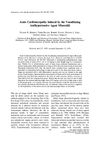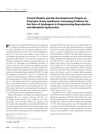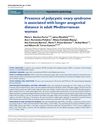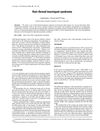
Search
for
Sort by
Research
840-870 / 1000+ results

research CXCR3 Blockade Inhibits T Cell Migration Into the Skin and Prevents Development of Alopecia Areata
Blocking the CXCR3 receptor reduces T cell accumulation in the skin and prevents hair loss in mice.

research Acute Diffuse And Total Alopecia: A New Subtype Of Alopecia Areata With A Favorable Prognosis
A new type of rapid hair loss called ADTA usually gets better on its own within 6 months.

research Direct Effects of Minoxidil on Epidermal Cells in Culture
Minoxidil promotes hair growth by increasing cell division and DNA synthesis.

research The Control of Hair Growth: An Overview
Hair growth is influenced by interactions between skin layers, growth factors, and hormones, but the exact mechanisms are not fully understood.

research Pinpoint White Dots in the Scalp: Dermoscopic and Histopathologic Correlation
Small white dots on the scalp seen with a dermoscope correspond to sweat ducts and vary with different hair disorders.

research Dihydrotestosterone Stimulates 5α-Reductase Activity in Pubic Skin Fibroblasts
Dihydrotestosterone increases the activity of an enzyme in pubic skin cells that converts testosterone to dihydrotestosterone.

research Reorganization of Hair Follicles in Human Skin Organ Culture Induced by Cultured Human Follicle-Derived Cells
Injected human hair follicle cells can create new, small hair follicles in skin cultures.

research Exogenous IGF-1 Promotes Hair Growth by Stimulating Cell Proliferation and Downregulating TGF-β1 in C57BL/6 Mice In Vivo
IGF-1 injections help mice grow more hair by increasing cell growth and blocking a hair growth inhibitor.

research Acute Cardiomyopathy Induced by the Vasodilating Antihypertensive Agent Minoxidil
Minoxidil can cause heart muscle damage in dogs.

research Morphometric Analysis of the Human Scalp Hair Follicle: Practical Implications for the Hair Transplant Surgeon and Hair Regeneration Studies
The research provides specific measurements for hair follicles that can improve hair transplant and regeneration techniques.

research Skin Wounds in the MRL/MPJ Mouse Heal with Scar
MRL/MpJ mice's skin wounds heal with scars, unlike their ear wounds which can regenerate.

research Animal Models and the Developmental Origins of Polycystic Ovary Syndrome: Increasing Evidence for the Role of Androgens in Programming Reproductive and Metabolic Dysfunction
High levels of androgens during early development may cause PCOS-like symptoms.

research Female Androgenetic Alopecia: An Update on Diagnosis and Management
FAGA diagnosis uses blood tests and trichoscopy, with treatments like topical minoxidil, oral anti-androgens, and hormone-modulating drugs.

research Metabolomic Biomarkers in Women with Polycystic Ovary Syndrome: A Pilot Study
Certain metabolites are lower in women with PCOS and could be potential markers for the condition.

research Malignancy and Cancer Treatment-Related Hair and Nail Changes
Hair and nail changes can indicate health issues, including cancer and side effects from cancer treatments.

research Presence of Polycystic Ovary Syndrome Is Associated with Longer Anogenital Distance in Adult Mediterranean Women
Women with polycystic ovary syndrome tend to have a longer distance between the clitoris and anus.

research Fibroblast Growth Factor 5-Short (FGF5s) Inhibits the Activity of FGF5 in Primary and Secondary Hair Follicle Dermal Papilla Cells of Cashmere Goats
FGF5s can block the effects of FGF5, which may help control hair growth in cashmere goats.

research The Transverse Anatomy of Androgenic Alopecia
The study found that horizontal sections of scalp biopsies are better for analyzing hair loss, showing fewer hairs and more fine hairs in balding areas.

research Mesotherapy Using Dutasteride-Containing Preparation in Treatment of Female Pattern Hair Loss: Photographic, Morphometric and Ultrastructural Evaluation
Dutasteride-containing mesotherapy effectively treats female hair loss, improving density and thickness with minimal side effects.

research Fructus Panax Ginseng Extract Promotes Hair Regeneration in C57BL/6 Mice
Panax ginseng extract helps mice grow hair.

research Assessment of Hair Loss: Clinical Relevance of Hair Growth Evaluation Methods
Effective hair loss assessment requires a mix of precise measurement methods.

research An Ultrastructural Study of Hair Fiber Damage and Restoration Following Treatment with Permanent Hair Dye
Permanent hair dye damages hair but it mostly recovers after 8 weeks; using certain hair care products can help repair it.

research Effect of Adenovirus-Mediated Expression of Sonic Hedgehog Gene on Hair Regrowth in Mice With Chemotherapy-Induced Alopecia
Using a gene therapy with the Sonic Hedgehog gene helps mice regrow hair faster after losing it from chemotherapy.

research Reversal of Androgenetic Alopecia by Topical Ketoconazole: Relevance of Anti-Androgenic Activity
Ketoconazole lotion can improve hair regrowth for some people with androgenetic alopecia.

research Hair Darkening in Porphyria Cutanea Tarda
Two patients with porphyria cutanea tarda experienced their grey hair turning dark again.

research Hair-Thread Tourniquet Syndrome
A hair strand caused a rare case of limb strangulation in a teenage girl with autism, and the condition is not always linked to child abuse.

research Alopecia Areata in C3H/HeJ Mice Involves Leukocyte-Mediated Root Sheath Disruption in Advance of Overt Hair Loss
Hair loss in mice starts with immune cells damaging hair roots before it becomes visible.

research Toxic Shock Syndrome: Recent Developments in Pathogenesis
Toxic shock syndrome is caused by a complex interaction of bacterial toxins and the immune system, and understanding this can help improve diagnosis and treatment.

research Endogenous Human Skin Equivalent Promotes In Vitro Morphogenesis of Follicle-Like Structures
Endo-HSE helps grow hair-like structures from human skin cells in the lab.